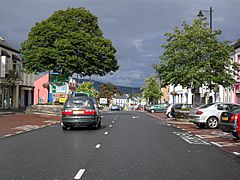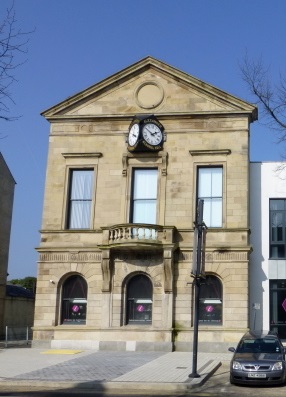Limavady facts for kids
Quick facts for kids Limavady
|
|
|---|---|
 Main Street |
|
| Population | 11,279 (2021 Census) |
| District |
|
| County | |
| Country | Northern Ireland |
| Sovereign state | United Kingdom |
| Post town | LIMAVADY |
| Postcode district | BT49 |
| Dialling code | 028 |
| Police | Northern Ireland |
| Fire | Northern Ireland |
| Ambulance | Northern Ireland |
| EU Parliament | Northern Ireland |
| UK Parliament |
|
| NI Assembly |
|
| Website | Causeway Coast and Glens Borough Council |
Limavady is a lively market town in County Londonderry, Northern Ireland. It sits with the beautiful Binevenagh mountain in the background. Limavady is about 17 miles (27 km) east of Derry and 14 miles (22 km) southwest of Coleraine.
In 2021, about 11,279 people lived in Limavady. The town's population has grown a lot over the years, almost doubling between 1971 and 2011. Limavady is part of the Causeway Coast and Glens area. Many new homes were built in the town, especially in the Bovally area, from 1988 to 2004. There is also a large industrial area nearby at Aghanloo.
Contents
A Look at Limavady's Past

Limavady and the areas around it have very old roots, going back to Celtic times. No one knows exactly when Limavady first started, but some guess it was around 5 CE. Old stories say that Saint Columba, a famous Irish saint, held an important meeting of kings near Limavady in 575 CE. This spot is now part of the Roe Park Resort.
Long ago, Gaelic Ireland was made up of many small kingdoms. Each was ruled by a family or clan. In the Limavady area, the O'Cahan family was very powerful. You can still see their influence everywhere.
The Legend of O'Cahan's Rock
One of Limavady's most famous historical spots is O'Cahan's Rock. A local legend says that during a surprise enemy attack, a dog belonging to an O'Cahan chief bravely jumped across the river. The dog went to get help from other clans. This amazing leap gave Limavady its name! Limavady comes from the Irish words Léim an Mhadaidh, which means "leap of the dog." You can visit this rock and other historical places at Roe Valley Country Park.
How the Town Grew
Limavady started as a small settlement during the Plantation of Ulster. This was a time when new towns were built in Ireland. In 1610, a man named Sir Thomas Phillips was given a lot of land in Limavady. This land included an old O'Cahan castle. Sir Thomas began building the "Newtown of Limavady." He designed it with roads crossing in a special pattern.
King James I officially made Newtown Limavady a town in 1613. It had a leader called a Provost and 12 Burgesses (town officials). By 1622, there were 18 houses and an inn. The town center had a flagpole, a cross, and even stocks (a device for public punishment).
Early Industries: Whiskey and Linen
Limavady has a long history with making linen and Irish whiskey. In 1608, King James I gave Sir Thomas Phillips permission to make and sell whiskey in the area. This was a very early license for distilling whiskey in Ireland!
The Limavady Distillery started in 1750 near the River Roe. However, Limavady didn't grow as much as other towns when linen making became very popular in the 1800s. So, it stayed a small market town until the late 1900s. The Limavady Town Hall, which is now part of the Roe Valley Arts & Cultural Centre, was finished in 1872.
World War II and Later Times
In 1941, RAF Limavady was opened just north of the town. This was an air base used during World War II for planes patrolling the Atlantic Ocean. The Royal Air Force left in 1945, but the base was used by the navy until 1958. After that, the land became farmland again.
During a difficult period in Northern Ireland's history, known as the Troubles, Limavady experienced some violence.
In 1987, Limavady became famous for an unexpected reason! It was where Richard Branson and Per Lindstrand landed after making the world's first transatlantic journey in a hot air balloon. They didn't plan to land there, but it became a memorable moment!
Local Areas: Townlands
Limavady first grew in a small area called Rathbrady Beg. It was originally known as Newtown Limavady. Over time, the town expanded into other nearby areas called townlands. These include:
- Bovally (meaning "townland of cows")
- Coolessan (meaning "nook of the little fort")
- Enagh (meaning "marsh")
- Killane (meaning "broad wood")
- Rathbrady Beg (meaning "little fort of St. Brigid")
- Rathbrady More (meaning "great fort of St. Brigid")
Fun Places to Visit
- Limavady is in the beautiful Roe Valley area. The Roe Valley Country Park is a great place to explore along the River Roe.
- You can find the birthplace of New Zealand Prime Minister Rt. Hon. William Massey on Irish Green Street. A nearby street, Massey Avenue, is named after him.
- The amazing Broighter Gold collection was found near Limavady in 1896. These very old and valuable gold objects are now in the National Museum of Ireland in Dublin.
- Jane Ross, who first wrote down the famous tune Londonderry Air, was born and lived in Limavady. There's a special plaque above her old house on Main Street.
Getting Around Limavady
Limavady is close to City of Derry Airport, which is about 9 miles (15 km) away. The Port of Londonderry is also nearby, about 13 miles (22 km) to the west.
Roads
In 2003, a new road was built around the north of Limavady. This bypass cost £11.5 million and helped reduce travel time on the A2 road between Derry and Coleraine.
Trains
Limavady used to have its own train line that connected to the main Belfast–Derry line. The Limavady railway station opened in 1852 but closed for passengers in 1950 and completely in 1955. Today, the bus station is on this site. Another station, Limavady Junction railway station, closed in 1976.
Now, the closest train station to Limavady is Bellarena, about 5 miles (8 km) away. From Bellarena, you can catch trains west to Derry~Londonderry or east to Castlerock, Coleraine, and even to Belfast Lanyon Place and Belfast Grand Central.
There's even a plan from 2021 to bring back a short part of the Limavady train line to restore services to the town!
Canals
The Broharris Canal was built in the 1820s. It was a cut about 2 miles (3 km) long on the south shore of Lough Foyle near Ballykelly. People in Limavady wanted a canal all the way to their town, but it didn't happen. The Broharris Canal was the closest they got to having a water link.
Schools in Limavady
Limavady has a great "education circle" where many schools are close together. There are four primary schools, three secondary schools, a regional college, and a special needs school.
Primary Schools
- Termoncanice Primary School
- Roe Valley Integrated Primary
- Limavady Central Primary School
- Drumachose Primary School
- Gaelscoil Leim an mhadaidh
Secondary Schools
- St Mary's High School
- Limavady Grammar School
- Limavady High School
Regional College
- North West Regional College
Special Needs School
- Rossmar Special School
Sports Teams
Limavady has several sports clubs for you to cheer for or even join!
- Wolfhounds GAC is the local Gaelic Athletic Association club.
- Limavady United F.C. (football)
- Roe Valley F.C. (football)
- Roe Rovers F.C. (football)
- Newtowne F.C. (football)
- Drummond Cricket Club (cricket)
People from Limavady
Many interesting people have come from Limavady, including:
- William Ferguson Massey – He became the 19th Prime Minister of New Zealand! He was born and went to school in Limavady before moving away.
- Ruth Kelly – A Labour Member of Parliament (MP) and a former Cabinet Minister in the UK government.
- Thomas St George McCarthy – An Ireland rugby player and one of the people who helped start the Gaelic Athletic Association. He also played football and cricket for Limavady teams.
- Dr. Muriel Robertson FRS – A very important scientist who studied tiny living things (protozoologist) and bacteria (bacteriologist).
- William Porter – He became the Attorney General (a top legal official) at the Cape of Good Hope in South Africa.
- John Scott Porter – A Presbyterian minister and professor who was very interested in preserving the Irish language.
- Jimmy McCurry – A folk musician often linked to the famous tune Londonderry Air.
- Gerry Mullan – A former footballer who played for teams like Glentoran and Everton, and for Northern Ireland.
- Samuel Young – The person who started the Limavady Brewery.
See also
 In Spanish: Limavady para niños
In Spanish: Limavady para niños


